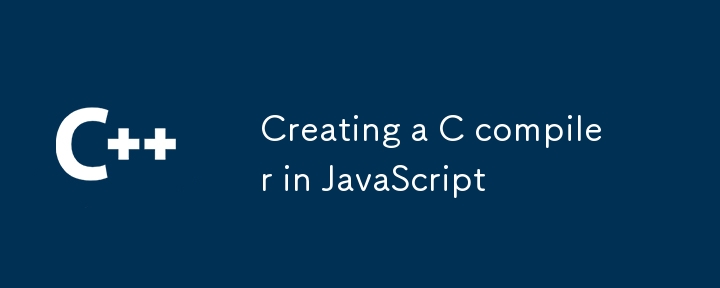Rumah > Artikel > pembangunan bahagian belakang > Mencipta pengkompil C dalam JavaScript
Mencipta pengkompil C dalam JavaScript
- PHPzasal
- 2024-07-18 01:42:311140semak imbas

Mencipta pengkompil C dalam JavaScript ialah projek yang kompleks dan bercita-cita tinggi yang melibatkan beberapa komponen, termasuk analisis leksikal, penghuraian, analisis semantik dan penjanaan kod. Di bawah ialah contoh ringkas dan peringkat tinggi tentang cara anda boleh mula membina pengkompil sedemikian. Contoh ini akan menumpukan pada analisis leksikal (tokenisasi) dan peringkat penghuraian, yang merupakan langkah pertama dalam menyusun kod C.
Langkah 1: Analisis Leksikal (Tokenisasi)
Penganalisis leksikal (lexer) menukar kod input C kepada aliran token.
class Lexer {
constructor(input) {
this.input = input;
this.tokens = [];
this.current = 0;
}
tokenize() {
while (this.current < this.input.length) {
let char = this.input[this.current];
if (/\s/.test(char)) {
this.current++;
continue;
}
if (/[a-zA-Z_]/.test(char)) {
let start = this.current;
while (/[a-zA-Z0-9_]/.test(this.input[this.current])) {
this.current++;
}
this.tokens.push({ type: 'IDENTIFIER', value: this.input.slice(start, this.current) });
continue;
}
if (/[0-9]/.test(char)) {
let start = this.current;
while (/[0-9]/.test(this.input[this.current])) {
this.current++;
}
this.tokens.push({ type: 'NUMBER', value: this.input.slice(start, this.current) });
continue;
}
switch (char) {
case '+':
this.tokens.push({ type: 'PLUS', value: '+' });
this.current++;
break;
case '-':
this.tokens.push({ type: 'MINUS', value: '-' });
this.current++;
break;
case '*':
this.tokens.push({ type: 'STAR', value: '*' });
this.current++;
break;
case '/':
this.tokens.push({ type: 'SLASH', value: '/' });
this.current++;
break;
case '=':
this.tokens.push({ type: 'EQUAL', value: '=' });
this.current++;
break;
case ';':
this.tokens.push({ type: 'SEMICOLON', value: ';' });
this.current++;
break;
case '(':
this.tokens.push({ type: 'LPAREN', value: '(' });
this.current++;
break;
case ')':
this.tokens.push({ type: 'RPAREN', value: ')' });
this.current++;
break;
default:
throw new TypeError('Unexpected character: ' + char);
}
}
return this.tokens;
}
}
Langkah 2: Menghuraikan
Penghurai menukar aliran token kepada pokok sintaks abstrak (AST).
class Parser {
constructor(tokens) {
this.tokens = tokens;
this.current = 0;
}
parse() {
let ast = {
type: 'Program',
body: []
};
while (this.current < this.tokens.length) {
ast.body.push(this.parseStatement());
}
return ast;
}
parseStatement() {
let token = this.tokens[this.current];
if (token.type === 'IDENTIFIER' && this.tokens[this.current + 1].type === 'EQUAL') {
return this.parseAssignment();
}
throw new TypeError('Unknown statement: ' + token.type);
}
parseAssignment() {
let identifier = this.tokens[this.current];
this.current++; // skip identifier
this.current++; // skip equal sign
let value = this.parseExpression();
this.expect('SEMICOLON');
return {
type: 'Assignment',
identifier: identifier.value,
value: value
};
}
parseExpression() {
let token = this.tokens[this.current];
if (token.type === 'NUMBER') {
this.current++;
return {
type: 'Literal',
value: Number(token.value)
};
}
throw new TypeError('Unknown expression: ' + token.type);
}
expect(type) {
let token = this.tokens[this.current];
if (token.type !== type) {
throw new TypeError('Expected ' + type + ' but found ' + token.type);
}
this.current++;
}
}
Langkah 3: Penjanaan Kod
Akhir sekali, penjana kod menukar AST ke dalam bahasa sasaran, yang boleh menjadi JavaScript atau mana-mana bahasa lain.
class CodeGenerator {
generate(node) {
switch (node.type) {
case 'Program':
return node.body.map(statement => this.generate(statement)).join('\n');
case 'Assignment':
return `let ${node.identifier} = ${this.generate(node.value)};`;
case 'Literal':
return node.value;
default:
throw new TypeError('Unknown node type: ' + node.type);
}
}
}
Menyatukan Semuanya
Berikut ialah cara anda boleh menggunakan lexer, parser dan penjana kod:
const input = `x = 42;`;
const lexer = new Lexer(input);
const tokens = lexer.tokenize();
console.log('Tokens:', tokens);
const parser = new Parser(tokens);
const ast = parser.parse();
console.log('AST:', JSON.stringify(ast, null, 2));
const generator = new CodeGenerator();
const output = generator.generate(ast);
console.log('Output:', output);
Ini akan menandakan input, menghuraikannya menjadi AST dan menjana kod JavaScript daripada AST.
Nota
Contoh ini sangat dipermudahkan dan hanya mengendalikan subset kecil bahasa C. Pengkompil C yang lengkap memerlukan pengendalian set token yang lebih besar, menghuraikan ungkapan kompleks, pernyataan, pengisytiharan, jenis dan menjana kod yang lebih canggih.
Atas ialah kandungan terperinci Mencipta pengkompil C dalam JavaScript. Untuk maklumat lanjut, sila ikut artikel berkaitan lain di laman web China PHP!
Artikel berkaitan
Lihat lagi- Ralat kompilasi C++: Fail pengepala dirujuk beberapa kali, bagaimana untuk menyelesaikannya?
- Ralat kompilasi C++: parameter fungsi yang salah, bagaimana untuk memperbaikinya?
- Ralat C++: Pembina mesti diisytiharkan di kawasan awam, bagaimana untuk menanganinya?
- Pengurusan proses dan penyegerakan benang dalam C++
- Bagaimana untuk menangani masalah pemisahan data dalam pembangunan C++